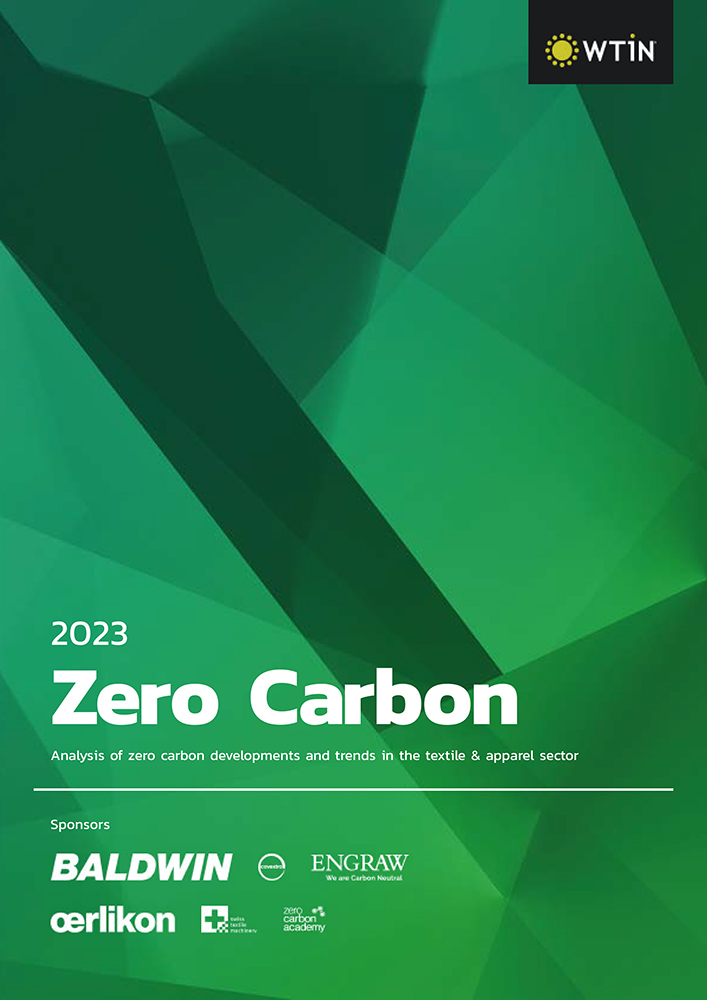
By Julia Cramer (head of Global Marketing Textile Coatings) and Dr Inga Bargende (business development manager & lab head Textile Coatings), Covestro Deutschland. As seen in WTiN’s Zero Carbon Report.
Fashion changes fast, but the textile industry needs to change faster. As one of the world’s biggest polluters, generating 1.2bn tonnes of CO2e [1] and 92 million tonnes of landfill [2] every year, textiles is quite rightly the growing target of calls for urgent sustainability transformation. With various challenges obstructing the path to circularity, however, especially for coated textiles, is a carbon-neutral industry just a fantasy? Or is it part of the fabric of a more sustainable global future?
Much of the answer depends on the willingness of those in the coated textiles value chain to turn this circular ambition into reality. Fortunately, more sustainable raw materials and recycling are both receiving increasingly more attention in the industry – with both crucial to turning an idealistic roadmap into a realistic one.
Laying the foundations for carbon neutrality
There are several key factors to making the shift successfully. First, legislative and regulatory pressure will be essential to forcing and accelerating change, with concrete actions such as the EU Strategy for Sustainable and Circular Textiles aiming to tackle fast fashion, textile waste and other sustainability issues. Meanwhile, certifications and labelling – including BlueSign®, ZDHC and OEKO-TEX® – are helping to increase transparency along the value chain and reduce textiles’ impact on people and the environment.
We also need a stronger pull for more sustainable textile materials from the consumer side. Currently, willingness to pay for recycled or reused products is still lower than for conventional ones. However, there are promising signs that attitudes are changing: when consumers are provided with third party-verified information about a product’s environmental benefits, their willingness to pay rises significantly [3]. It is up to the textiles production value chain to respond by delivering more sustainable products to meet market demand.
Here, collaboration is fundamental. A challenge the size of carbon neutrality cannot be overcome in isolation – and that requires different players along the coated textiles value chain to work together to drive and support the sustainability transition. Meanwhile, the importance of cooperation with industries beyond textiles should not be overlooked. There is much to be learned, for example, from the efforts of the packaging sector to develop new technologies for better plastic recycling – efforts that could be woven into those of the textiles community.
Because, ultimately, our ability to make coated textiles carbon neutral depends as much on end-of-life solutions as on, design, efficient production and more sustainable raw materials. This is where another major factor comes into play: technological and material developments.
Where functional meets sustainable
The good news is that the industry does not need to start completely from scratch: there are some material and technological solutions already in place. Part of the beauty of coated textiles, for instance, is their potential to combine functionality with more sustainability. Coatings can make fabrics breathable, waterproof and abrasion resistant – to give just a few examples of properties that not only boost performance, but also increase product longevity. Nevertheless, coating textiles means adding layers: layers that in turn make products harder to recycle.
Recycling coated textiles is still a work in progress. Around the world, there is a significant lack of solutions for separating waste textiles and enabling society to extract the maximum possible value from used components, in line with the goals of a circular economy. Considering that 99% of recycled textile polyester fibres come from plastics bottles [4] and that the packaging industry aims to create a closed loop [5], the feedstock for the textiles industry is likely to diminish. The textiles ecosystem therefore needs to come up with a long-term solution of its own [6]. This is arguably the key challenge facing the industry and if the solutions we need are to be successfully deployed, we must grow alignment and partnerships between businesses, academic institutions and governments. For instance, Covestro, one of the leading industry players in textile coatings, is engaged in collaborations to develop material and recycling technologies to facilitate the de-coating of textiles, in turn enabling the reuse of textile materials to produce new fibres.
Given that effective processes for coated textile recycling are not yet in place, it is clear that coatings need to be designed for circularity from the raw material stage. This will, once the necessary end-of-life infrastructure is ready, enable the industry to put the world’s limited resources to good use and recover as much as possible from used products for recycling along the value chain. Indeed, this is a core principle for Covestro, whose portfolio already contains solutions to help the industry on its way to carbon neutrality.
Waterborne, biobased and biodegradable: the power of PUDs
The first step is to enable the shift from solvent-based polymer resins to waterborne polyurethane dispersions (PUDs). Covestro has supported this shift for several years thanks to the introduction of its water-based INSQIN® portfolio, whose textile coating products have a global warming potential (GWP) up to 45% lower than that of solvent-borne equivalents*. By using these water-based resins, manufacturers of functional textiles and synthetic leather can significantly reduce their environmental footprint. Better yet, with the partly biobased PUDs in Covestro’s Impranil® CQ portfolio, textile coatings can be made even more sustainable, delivering a further reduction in GWP.
PUDs also play an important role at the other end of the product life cycle. Although reuse, recovery and recycling are the ultimate goals of circularity, for specific applications such as agricultural or personal care products, this is not always possible. In such cases, biodegradable polymers can also support circularity. Covestro’s Impranil® DLN-SD is a PUD showing promising degradability rates in water: 66% in 28 days (OECD test standard 301F). High-performance, versatile, biodegradable coatings such as Impranil® DLN-SD can help reduce the risk of microplastic leakage from discarded textiles and lower the industry’s end-of-life impact.
Another key step to offer climate neutral textile products can be mass balancing. Based on the third-party International Sustainability & Carbon Certification (ISCC) PLUS standard, this certified and yet proven approach at Covestro ensures the incorporation of specific feedstock material such as biomass early into the value chain.
Bringing vision to life
Solutions like these are already contributing to more sustainability in coated textiles, but it is clear that delivering carbon neutrality is a complex challenge, with plenty of work still to be done. The roadmap to achieving this goal is ambitious, which is no surprise given the distance our industry must cover to reach our destination.
By innovating together, advocating for regulations and infrastructure and raising public awareness of carbon neutral solutions, actors such as Covestro will continue to lay the foundations on which we can build a solid architecture of sustainable materials and technologies. Through this, the industry will realise its vision of a fully circular, carbon-neutral coated textiles industry.
*Global warming potential (GWP) for 1,000 sqm synthetic leather is 12,700 kg CO2e for a solvent-borne process and 6,900 kg CO2e for a waterborne process; 85% of the impact reduction results from a less energy intensive production process (no DMF recovery is needed, less oven utilisation)
-
References
[1] Ellen MacArthur Foundation. (2017) A New Textiles Economy: Redesigning fashion's future. Available at: https://ellenmacarthurfoundation.org/a-new-textiles-economy. [Accessed: 25 January 2023]
[2] Igini, M. (2022). 10 Stunning Fast Fashion Waste Statistics. Earth.org. Available at: https://earth.org/statistics-about-fast-fashion-waste/ [Accessed: 25 January 2023]
[3] Pretner, G. Darnall, N. Testa, F. Iraldo, F. (2021) Are consumers willing to pay for circular products? The role of recycled and second-hand attributes, messaging, and third-party certification. ScienceDirect. Available at: https://www.sciencedirect.com/science/article/abs/pii/S0921344921004973 [Accessed: 25 January 2023]
[4] Manteco. Is recycled polyester a sustainable choice? Available at: https://manteco.com/is-recycled-polyester-a-sustainable-choice/ [Accessed 25 January 2023]
[5] The CocaCola Company. (2021) Endlessly Refreshing: CocaCola North America Rolls Out Bottles Made from 100% Recycled PET Plastic. Available at: https://www.coca-colacompany.com/news/packaging-sustainability-in-united-states [Accessed 25 January 2023]
[6] European Fruit Juice Association (AIJN), Changing Markets Foundation, Natural Mineral Waters Europe (NMWE), UNESDA Soft Drinks Europe and Zero Waste Europe. (2022) PET downcycling is not circularity – the case for closed-loop recycling. Euractiv. Available at: https://www.euractiv.com/section/energy-environment/opinion/pet-downcycling-is-not-circularity-the-case-for-closed-loop-recycling/ [Accessed 25 January 2023]
Have your say. Join the conversation and follow us on LinkedIn






